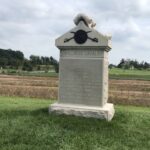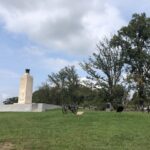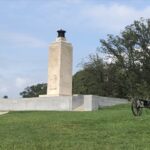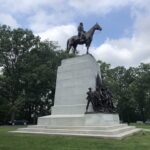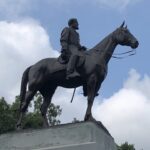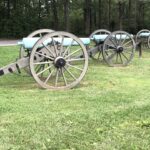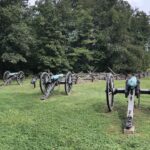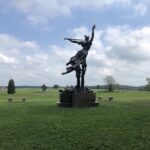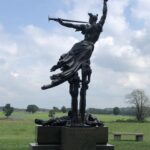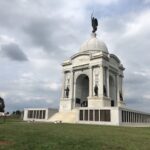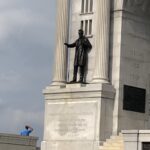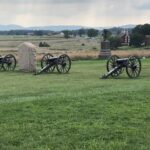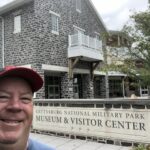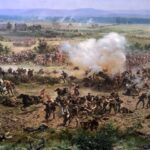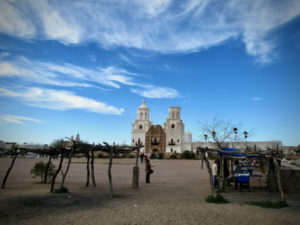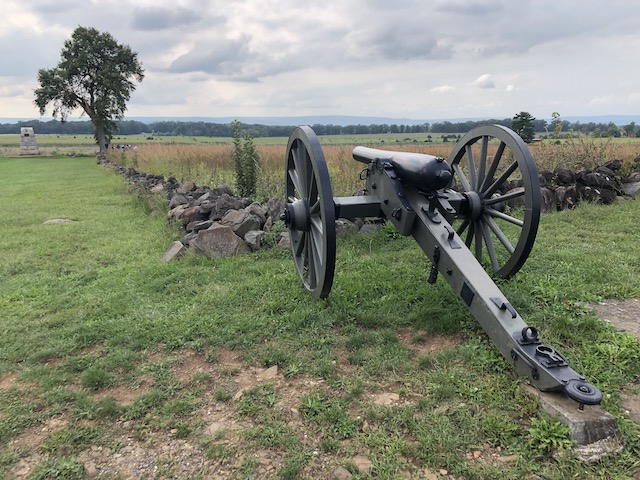
Compared with the Flight 93 National Memorial, the Gettysburg National Military Park is hysterical – a veritable barrel of laughs. On the advice of my attorney, I am bound to say that I’m being facetious here.
But it’s kinda true. Gettysburg is to the American Civil War what 100 years of box scores is to baseball. The battle’s hobbyist historians get utterly lost in the details – obsessed, like baseball’s Sabermatricians. Real life-of-the-party types. Don’t worry. I won’t go there in this blog.
Gettysburg is a place to spend three (or more) days, not hours. But that’s all I have. And that’s why God invented the professional tour guide.
So how, after three incredibly informative hours with my private guide, Dr. Rick Schroeder, did I manage to humiliate myself? In only five minutes inside the Gettysburg Cyclorama? Here’s how it went down.
On the way to Gettysburg, at the Flight 93 memorial, I meet a man who says his favorite thing at the military park is the cyclorama. I have absolutely no idea what a cyclorama is, but just assume it’s some sort of miniature model of the battlefield. Probably made out of Lincoln Logs or LEGO. Whatever.
My tour ends at 4 pm, so I have just enough time to hustle over to the visitor center, which closes at 5 pm, to see what made a grown man – literally a high school teacher from Ohio – almost pee in his pants.
It’s 4:20 pm. I ask the guard inside the door if I need to wear a mask (“No”), then run over to the ticket window. The intro film, which leads up to the cyclorama, is the last one of the day, and it’s already started.
I’m practically begging, so the nice lady behind the ticket window tells me to wait until the film is over, then join the small group when they go upstairs. She then unexpectedly comps me the $15 ticket. Score!
I go upstairs with the group. There are no Lincoln Logs. No LEGOs. I’m standing on a platform in the middle of a 360-degree cylindrical painting. French artist Paul Philippoteaux – with the help of around 15 men – painstakingly reconstructed the entire battle. The thing, completed in 1883, is 377 feet long and 42 feet high and weighs 12.5 tons. It’s life-size figures are incredibly realistic, and there’s a 3-D element, with objects extending in and out of the painting – like what you might see in the background at a play.
After a short presentation, the docent talks a bit about the artist and his methods. He also says that all the generals from the battle are incorporated into the painting, which also includes a wounded Lincoln (symbolizing a “wounded nation”) and the artist himself.
I wait patiently, while the other dolts – some of whom may have actually fought in the Revolutionary War – ask their meaningless questions. Finally, I get my chance.
“So, you said all the Gettysburg generals are in this painting. Where is Grant in this painting?” I ask. “Can you point him out?”
“Well, Grant wasn’t in Gettysburg (you moron),” the docent says.
“He was in Vicksburg (you numbskull),” says one of the Revolutionary War veterans.
“The Union Generals at this batter were Hunt and Reynolds, Buford and Doubleday (you imbecile) – not Grant,” shouts another.
It’s a failure of epic proportions and I may never ask a question in a public setting again. I’ve humiliated not only myself, but Dr. Rick Schroeder, my Gettysburg guide.
It’s my “Where’s the basement in the Alamo?” moment (see, “Pee-wee’s Big Adventure,” 1985). Utterly disgraceful.
REBUTTAL: In my defense, the docent DID say the artist painted “all the generals” in there. And he DID paint Abe Lincoln (who wasn’t there) and included himself (also not there) – so maybe Grant should have been included. I rest my case.
ODDS AND ENDS
Humiliation aside, I did learn some very cool things on my three-hour tour … a three-hour tour:
- Smokeless gunpowder had not been invented yet, so the cloud of smoke generated by the barrage during Pickett’s Charge contributed mightily to the Confederate failure. Not only were they launching cannon balls way past the Union line, they couldn’t see that there actually was NOT a gap in the formation, which ultimately led to their doomed charge.
- During Pickett’s Charge, my guide said, it was 160 Confederate cannon against 100 Union. The rate of cannonball fire was 3 per second, and the battle was so loud, it could be heard in Pittsburgh and Baltimore!
- Confederate General Robert E. Lee lived on what is now Arlington National Cemetery, having married into the family who owned the property. After the war, the government basically stole the property at a tax sale ($92.07 was owed). Amazingly, there are descendants of Blacks who worked for Lee that remain employed on the same grounds.
- There were 51,000 casualties – killed, wounded or missing – during the three-day battle. On Day 2 at Gettysburg, there were 20,000 casualties in only seven hours. That’s not a higher figure but IS a higher rate than what occurred at the Battle of Antietam, which recorded 23,000 in 12 hours.
- Eighty percent of the deaths that occurred during the Civil War were the result of disease. And contrary to the usual depictions of soldiers suffering and in misery, general anesthesia was used on 90 percent of the wounded.
- Union General “Mad” Daniel Sickles donated his amputated leg, which was blown off by a 12 pound cannonball, to a medical museum in Washington. He used to take friends to see the leg, and visited on every anniversary of its amputation. It’s currently on display at the National Museum of Health & Medicine.
- The average age of the 1,500 Civil War soldiers who attended the 50th anniversary of the battle was 94.
- President John F. Kennedy was asked to speak at the 100th anniversary of Abraham Lincoln’s November 19, 1863, dedication of the battlefield cemetery – where Lincoln delivered his “brief remarks” (aka the Gettysburg Address). But former President Dwight D. Eisenhower, who had retired to Gettysburg, got the call instead, As a result, Kennedy went to Dallas, where we all know what happened three days later.
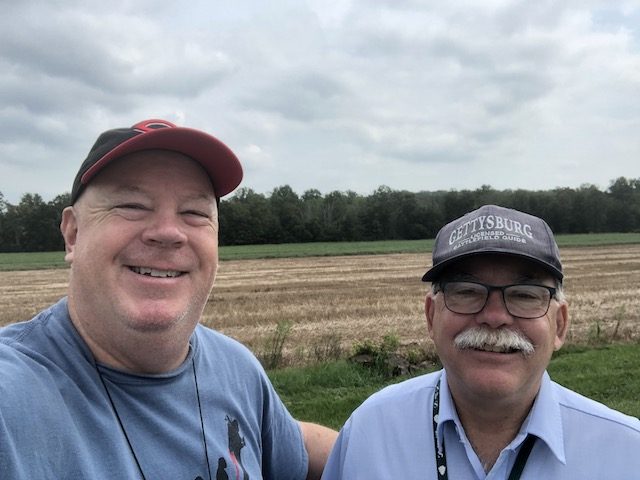
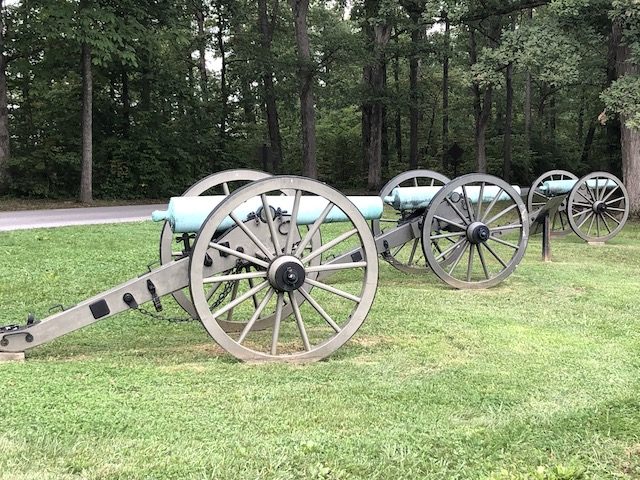
IF YOU GO TO GETTYSBURG: As this was a last minute, one-day visit, I took the advice of my sister Lorri (which I rarely do) and contacted the Association of Licensed Battlefield Guides. Her friend had specifically recommended Bill Trelease. I called Bill, but he was unavailable. He said I should just call the organization directly, which I did. They did all the legwork and found me Dr. Rick Schroeder, who happens to be pals with Trelease. In a stroke of serendipity, he also happens to have studied medicine at Northwestern University in Chicago, gone to Notre Dame for his undergrad work and loves sports, especially baseball. Needless to say, we had a lot to talk about. He is fantastic. Tour cost: $120 for three fabulous hours (not including tip). Other recommendations: Dobbin House Tavern, Blue & Gray bar and grill. Hotel: I stayed at the Comfort Inn & Suites ($159), which is in a great location but nothing special. There is a fabulous inn that is actually inside the park on the drive that still includes privately-owned homes.
IMPORTANT: From what I saw, Gettysburg is mostly viewed by vehicle. At 6,000 acres, it’s an immense park. And there are 1,400 monuments spread far and wide. I did see a few cyclists, and the main paved road is smooth and relatively flat – so biking is clearly an option. My guide drove me around in a pattern that followed the battle, visiting the primary Day 1, 2 and 3 locations. If you only have a single day, that seems to be a logical choice. And if you want to walk – have at it!
BOOKS: My guide also recommends two books on Gettysburg: “The Killer Angels: The Classic Novel of the Civil War” (Michael Shaara). This is what the 1993 film, “Gettysburg” is based upon. And “American Scoundrel: The Life of the Notorious Civil War General Dan Sickles” (Thomas Keneally, author of Schindler’s List).


